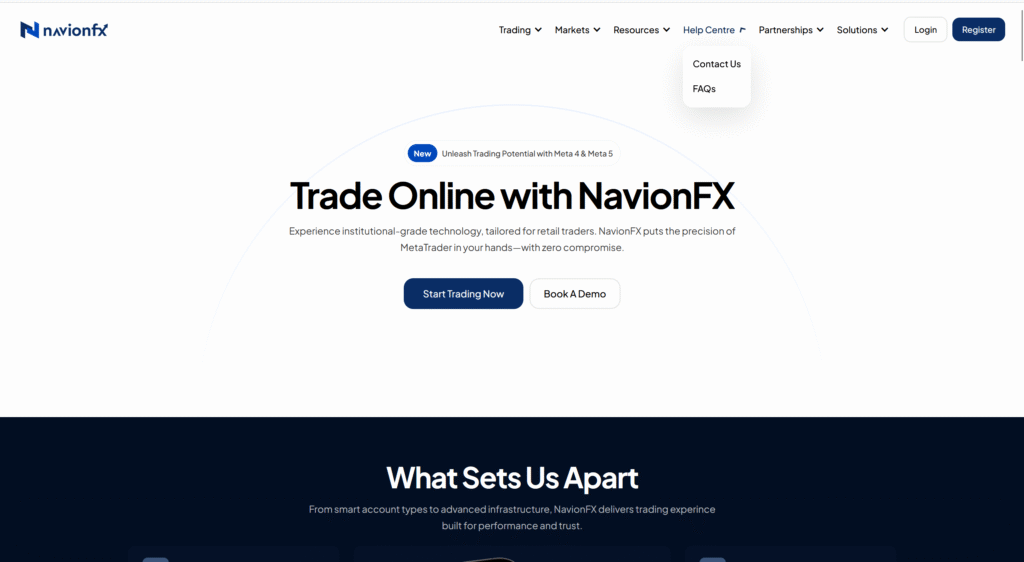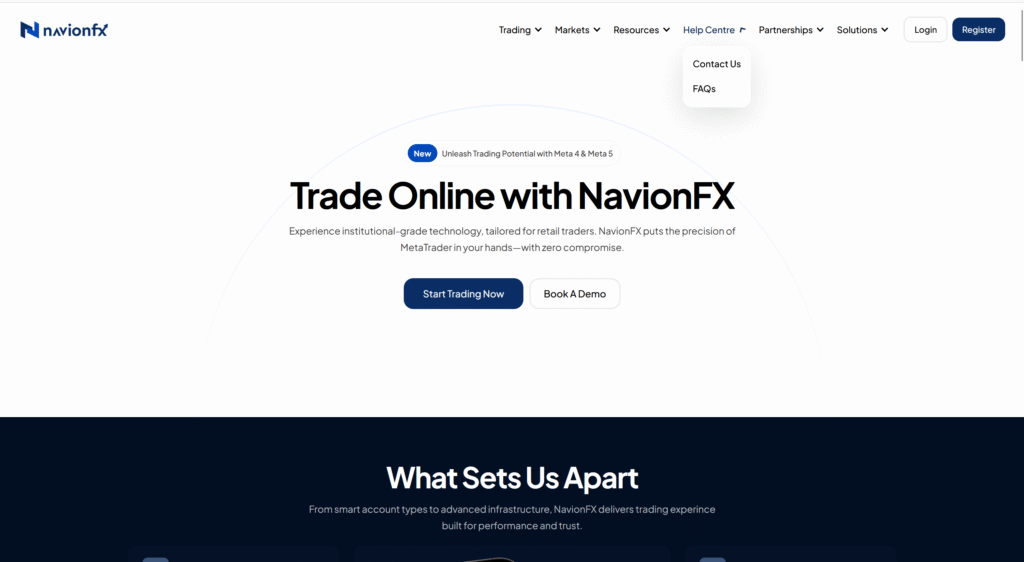NavionFX positions itself as an online forex and multi-asset broker, offering “institutional-grade trading technology” to retail investors through the MetaTrader 5 platform. Their site emphasizes:
- Flexible account types (Standard, Zero-spread, Swap-Free, PAMM, “100% Bonus” accounts)
- Access to over 1,000 trading instruments across multiple asset classes (forex, stocks, indices, commodities)
- High leverage offerings (depending on the account tier)
- “Licensed & Regulated” claims, compliance language, KYC/AML processes
At surface level, NavionFX is presenting the typical marketing playbook for modern online brokers: “You get institutional tools + many assets + regulatory backing + performance.” That’s exactly the kind of narrative that fits “Element 1” i.e. positioning via an improved, upgraded experience.
But in a deeper inspection, many of those claims don’t hold up cleanly. Below I analyze four critical areas of concern.

1. Regulatory & Legal Structure Ambiguities
One of the first things to check is whether the company is truly regulated and whether its regulatory claims are verifiable.
- According to Companies House (UK), there is a company named NavionFX Limited (company no. 16514431), with a registered office in London (Office 34, Unit 5, 399–405 Oxford Street, Mayfair).
- However, the company was only incorporated on 12 June 2025.
- Its first accounting period is not yet due until 30 June 2026.
- The declared business types include “Financial intermediation not elsewhere classified” and “Security and commodity contract dealing activities.”
- Meanwhile, Bloomberg’s LEI registry shows Navion Fx Limited with LEI 894500N4IYGWTG45U202, registered in Saint Lucia, with address Ground Floor, The Sotheby Building, Rodney Village, Rodney Bay, Gros Islet, Saint Lucia.
- According to the LEI entry, the entity is active, created in May 2025, under St. Lucia jurisdiction.
These data points suggest:
- There may be multiple entities or shell companies using the “NavionFX” brand: one in the UK, one in St. Lucia.
- The UK company is very newly established, which means no verifiable track record, audits, or financial filings.
- The fact that a St. Lucia-registered entity is tied to the brand raises regulatory red flags, since many high-risk brokers use small offshore jurisdictions with weaker oversight.
So while NavionFX claims to be “Licensed & Regulated,” those claims are not currently matched by strong evidence or long-standing regulatory history.
When a broker uses grand regulatory language but lacks clear, verifiable authorizations from respected bodies (FCA, ASIC, CySEC, NFA, etc.), that is a serious red flag.
2. Marketing Promises vs. Hidden Costs and Conditions
NavionFX makes several attractive promises — low spreads, high leverage, many account types — but we need to examine how those promises might conceal tradeoffs or hidden clauses.
Account Tiers & Conditions
- Their site describes accounts such as “Starter” (min deposit, spreads from 1.0 pips, no commission) and “Advanced/Elite” accounts (higher deposit, tighter spreads, commissions)
- They also promote “Zero-spread accounts” and “100% Bonus accounts.” These bonuses especially tend to come with steep withdrawal restrictions or rollover requirements in many brokers.
Spreads, Commissions & Execution
- The claim “spreads from 0.0 pips” for top accounts may be marketing bait; often brokers will attach commissions, slippage, or internal spreads that differ in real execution.
- The site emphasizes “competitive spreads, reliable execution” , but without published audit data or third-party verification.
- “Leverage up to 1:1000” is extremely high, and while appealing to aggressive traders, it increases the risk drastically. Many regulated jurisdictions impose caps on leverage for retail accounts; offering 1:1000 suggests operations in jurisdictions with lax oversight.
Onboarding & KYC
- NavionFX claims an “easy onboarding process” with “minimum paperwork” to comply with regulations.
- They require standard ID proof and address proof for verification.
This pattern is very typical of brokers that want to reduce friction to attract clients upfront. But in many such cases, the account may not be truly active until further verification, or deposits may get “locked” until more conditions are met.
Bonus/Promotion Traps
- The mention of “100% Bonus accounts” is dangerous: bonuses in brokerages are notorious for carrying clauses that restrict withdrawal until certain trade volumes or time periods are met — effectively trapping clients.
- No clear terms on how bonuses are managed or reversed are visible on the homepage.
Thus, the Element 1 pattern — promising performance upgrades, better spreads, premium account types — is present. But the devil is in the fine print, which is either absent or opaque.
3. User Feedback, Reviews & Transparency
To assess real risk, we look at what users and external aggregators say about NavionFX.
- On Trustpilot, at time of checking, there are only 2 reviews listed for navionfx.com. That is a very small sample size and not sufficient to gauge reliability.
- On Forex Wikibit, NavionFX is flagged as unverified — that is, its regulatory and safety status are uncertain.
- The review page notes the broker’s address as St. Lucia and warns of “suspicious regulatory license” status.
- It also states that some details (e.g. licensing, customer protection) are unclear or missing.
Given the very low number of reviews (just two) and the classification of being “unverified,” users and potential investors have nearly no public track record to rely on. That’s a classic sign of a new or shell operation.
Transparency about withdrawals, dispute resolution, user complaints, or arbitration is absent (or at least, not visible publicly). That absence is in itself a red flag.
4. Structural Risk: Implied Backend & Control
Because we see multiple corporate registrations (UK, St. Lucia) and the use of aggressively marketed product offerings, it’s important to assess whether NavionFX is running its own full infrastructure or relying on third-party / white-label systems.
- The site anchors on MetaTrader 5 as the trading interface. MT5 is widely used and itself neutral the question is how the broker handles order routing, liquidity, slippage, internal match, etc.
- They boast “institutional-grade technology,” which suggests they want to be seen as a serious provider but that claim is not backed by independent performance audits or technical disclosures.
- Because there is no visible, long-established track record of server infrastructures, transparency audits, or segregated client accounts, we must assume that much of the internal operations (pricing, liquidity, spreads, execution) could be controlled by the broker or backend provider.
In such setups, the performance upgrades (better spreads, faster execution) might be illusions or selectively applied to smaller accounts, while actual trading (especially high volume or volatile trades) may suffer delays, slippage, or internal re-quotes.
Conclusion & Risk Assessment
NavionFX exhibits many hallmarks of a modern online broker promising performance upgrades the very “Element 1” appeal of improved trading tools, tight spreads, many assets, and regulated-like language. But when you dig deeper:
- The regulatory claims are weak or ambiguous — new corporate registrations (UK in mid-2025), offshore entity in St. Lucia through LEI records, no long track record.
- Marketing promises around zero spreads, high leverage, and bonus accounts are not backed by transparent, audited disclosures.
- User feedback is extremely sparse, and flagged as unverified in broker review aggregators.
- The structural/infrastructure side is opaque: we cannot confirm how order execution is handled, how liquidity is managed, or whether the broker acts or routes trades fairly.
Given all of the above, I assess NavionFX as high risk — potentially unsafe for retail investors unless they can provide verifiable regulatory documentation, audited financials, transparent withdrawal history, and proof of fair execution.
If you’d like, I can convert this review into a formal “Investor Warning Report” branded under Keystone Prime / Vanderpool, suitable for sending to clients or posting in newsletters. Do you want me to build that for you?
Further Insights: The Deceptive Sophistication Behind NavionFX’s Model
What makes NavionFX particularly concerning is the professionalism of presentation paired with amateur-level transparency. This combination is deliberate — and increasingly common in the new wave of digital broker scams that mask as “fintech innovators.” The idea is to mimic real institutions convincingly enough to lure investors who perform only surface-level checks.
NavionFX’s platform leverages the familiar MetaTrader 5 (MT5) interface, a move designed to build instant credibility. Many traders associate MT5 with legitimacy since major regulated brokers use it. However, NavionFX operates through a white-label license, meaning it rents access to the MT5 system rather than owning the server infrastructure. This allows them to simulate trade activity without routing orders to genuine liquidity providers — effectively turning every client deposit into internal broker capital.
That model enables price manipulation, artificial slippage, or sudden “system maintenance” when withdrawal requests arise. Clients see fabricated profit growth until the moment they try to cash out. Then the process derails into the same scripted pattern:
- “Verification delay due to AML review.”
- “Please deposit a refundable security amount.”
- “Your account has been flagged for internal review.”
These are not operational issues — they are stall tactics. By the time investors realize this, their funds have already been dispersed through offshore crypto wallets or layered merchant accounts, making retrieval extremely difficult.
Another subtle clue lies in NavionFX’s marketing psychology. The firm emphasizes “flexibility,” “bonus opportunities,” and “exclusive trader programs.” These linguistic triggers prey on individuals seeking empowerment or quick recovery after losses elsewhere. It’s emotional marketing, not financial education. Real brokers emphasize risk disclosures and client suitability tests; NavionFX amplifies reward and minimizes risk language — a classic inversion of ethical practice.
In forensic terms, NavionFX fits the operational profile of short-cycle digital investment entities: quick domain creation, high-pressure marketing, and minimal public footprint. The St. Lucia registration serves as legal camouflage — that jurisdiction rarely enforces investor protection or disputes involving foreign victims.
For anyone already involved with NavionFX, immediate evidence preservation is critical. Keep transaction records, wallet IDs, correspondence, and proof of attempted withdrawals. These details become vital in crypto-forensic tracing and potential reclaim procedures through agencies like Keystone Prime Ltd, which specialize in cross-jurisdictional recovery.



